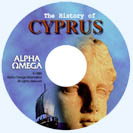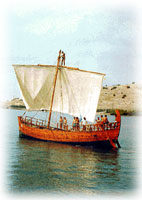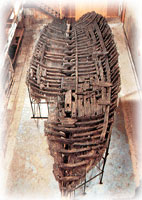 |
||||
|
The Kyrenia Ship
"If you break up Greece into pieces the three things you are going to get are an olive tree, a vineyard and a ship. With these three things you can rebuilt the country". The above words belong to a famous poet and there is no doubt that the Kyrenia ship, the oldest Greek vessel ever excavated, is a unique monument not only for Cyprus but also for the history of sea archaeology. This trading ship was loaded with Rhodian wine in amphorae (big jars) and volcanic grain from the island of Kos. There are indications that the vessel made some port on Cyprus and on its way out it sank less than a mile of Kyrenia. From evidence gathered so far it is suggested that the Kyrenia ship was operating between Dodecanese islands, Cyprus and Syria, along the Anatolian coast. The ship was discovered by Andreas Cariolou, a Cypriot diver, in 1967. The U.S Professor Michael Katzev of the American Institute on Nautical Archaeology met with Cariolou and made a preliminary research on the wreck. Then, the necessary funding was secured from the United States and the excavation of the ship began in June 1968. A team of forty members, coming from twelve different countries, including doctors, photographers, divers, technicians was formed. The ship had a length of 14,75m (47 ft) and width 3,4m (14,5 ft) with 1,4m at the bow and the stern. It is estimated that the sail’s dimensions were 10.7m times 6m (64m2). The ship was covered with a couple of inches of sand and shell debris. This thin sand deposit was the main reason to help preserve the wood for a period of 2,200 years. The archaeologists decide to lift the whole wreck rather than sections of it. This was achieved by tagging all the timbers after drawing and using the new technique of stereo photography. With this technique, the third dimension is attributed and the volume of both the cargo and the ship can be specified. The timbers were then dismantled by the use of a pneumatic saw. The first things to be pulled up were the 404 amphorae filled with more than 10,000 almonds. The carbon derived from them was not only used for the radiometric detecting of the ship but also to specify the date of the almonds at 212-324 BC. With the same method of radio carbon, the bronze coins found are dated around 345-433 BC. It is finally estimated that the ship was 300 years old when lost. The 404 amphorae are dated at the end of the 4th century BC and three different kinds of then were pulled up. The Small and Large Rhodian and the Samian amphorae indicate that they were loaded from different sea ports of Rhodos, Samos and Cyprus. Only 34 amphorae were sealed with the letters "API" which probably specify the manufacturer’s initials. Three Samian amphorae had an "O" typed and encircled on their handles. Only seven bronze coins were found but two of them help to specify the wreck’s era. One of the coins was cut during the Antigonos Monofthalmos (316-310 BC) reign and had a shield with a lion’s head on the one side and a Macedonian helmet on the other. The second coin was cut during the reign of Dimirtios Poliorkitis (306-294 BC), son of Antigonos, and had a head with a helmet at the front and a ship’s bow at the back. The eight spearheads are considered to be an important find. The fact that some of the spearheads were bend enabled the scientists to state that the ship was attacked by pirates. This point of view is enforced by the fact that no personal belongings of the crew or precious objects, other than the seven coins, were found. It is believed that the ship’s crew was consisted by four sailors. There were four sets of domestic utensils including four wooden spoons, four plates, four oil jugs, four plates and a copper cauldron. After pulling up the ship its wooden hull was placed in a huge tank filled with fresh water. This water was constantly changed in order to remove the sea water and the sand from the wood cells. The hull was first dried and then injected with a special plastic type of resin for its chemical preservation. Under the guidance of Ms. Francis Talbot-Vasiliadou a first-time experimental chemical preservation method is used firstly for small wood pieces and secondly for larger pieces. The whole chemical process lasted two years followed by the assembling of the ship. This complicated task was undertaken by Professor J. Richard Steffy, a representative of UNESCO’s Archaeological Department. The excavation of Kyrenia ship gave the opportunity to scientists to apply new techniques for excavating and preserving such objects. Its antiquity is unique since pre- Roman ships are rare. Both the ship and its cargo are now exhibited in the Kyrenia Castle which for the time being is inaccessible to the people of Cyprus, due to the Turkish invasion in July, 1974. |
 |
|||

